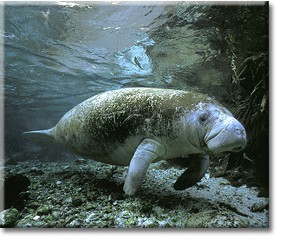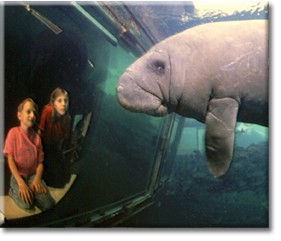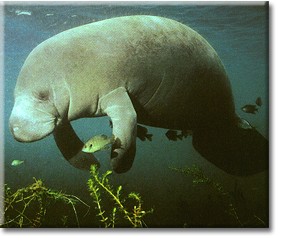World Famous Citrus County Manatees

Citrus County Florida supports the largest concentration of manatees in a natural spring area.

A manatee has a face only Mother Nature could love. Once you meet a manatee, you're hooked The official marine mammal of the state of Florida, manatees are nearsighted, slow-moving herbivores that average about 10 feet in length and weigh in at roughly 1,200 pounds. Amazingly, considering their size, manatees are remarkably gentle. They are not territorial and they have no natural enemies and no known agenda; they pretty much just swim, sleep and eat.
Citrus County Florida is special and privileged because it supports the largest concentration of manatees in a natural spring area. Individual manatees often return to the same wintering areas year after year. The Crystal River National Wildlife Refuge is unique in that it was established specifically for the protection of the endangered West Indian Manatee. You are welcome to visit the refuge year round, however the best time to see the manatees is November through March when the weather is at its coolest and manatees seek the warm water springs.
You can also visit local manatees at the Homosassa Springs State Wildlife Park located in Homosassa, Florida on US 19. The state park has a number of manatees in residence year-round. The huge windows in the underwater observatory are perfect for watching them frolic and pose for your photos. Also, arrangements can be made with local tour operators for manatee observation via scuba diving, snorkeling, canoeing, kayaking or boat rides.
With all of these natural wonders, it's easy to understand why Citrus County is often called "Mother Nature's Theme Park."

Manatee Facts
Species Name: West Indian Manatee
Manatee Description:
A large, seal-like body that tapers to a spatulate tail. Two forelimbs with three or four nails on each. Skin is thick and wrinkled with stiff whiskers on upper lip.
Manatee's Color:
Gray or gray-brown.
Manatee's Size:
Manatees can grow to 13 feet and weight over 3,000 pounds.
Manatee's Behavior:
Gentle and slow moving. Most of their time is spent eating, resting, and in travel. Often shy and reclusive. No system of defense and completely harmless.
Manatee's Sight:
Depth perception may be limited. Can differentiate colors.
Manatee's Hearing:
Manatees can hear very well despite the absence of external ear lobes.
Manatee Communication:
Manatees emit sounds that are within human auditory range. They make sounds such a squeaks and squeals when frightened, playing or communicating, particularly between a cow and its calf.

Manatee Breathing:
Nostrils are on the upper surface of the snout which close tightly like valves when submerged. Surfaces to breathe every few minutes depending upon amount of activity.
Manatee Habitat:
They can be found in shallow, slow-moving rivers, estuaries, saltwater bays, canals, and coastal areas, particularly where seagrass beds flourish.
Manatee Range:
Within the United States, they are concentrated in Florida during the winter, but can be found in summer months as far west as Louisiana and as far north as Virginia and the Carolinas. The West Indian manatee can also be found in the coastal and inland waterways of Central and South America as far south as Recife, Brazil.
Manatee Food Source:
Aquatic plants. Manatees are completely herbivorous and can eat 10-15% of their body weight daily.
Manatee History:
Manatees are believed to have evolved from a wading, plant-eating animal, and share a common ancestor with the elephant.
Manatee Population:
There are approximately 2,400 West Indian manatees left in the United States.
Manatee Reproduction:
Females are probably not reproductive mature until 5 to 9 years old and males not until 6 to 9 years old. It is believed that one calf is born every 2 to 5 years. Twins are rare in the wild. Gestation period is around 13 months.
Manatee Problems:
Human Related: boat / barge collisions, loss of habitat, crushing or drowning in flood gates, poaching, ingestion of fish hooks and monofilament line, entanglement in crab trap lines, pollution. Natural: Cold related, "red tide".
Manatee Conservation:
Public acquisition and/or creation of sanctuaries in critical areas; research covering biology, mortality, behavior, habitat, and population; implementation of management plans; establishment of regulatory speed zones and the levying of fines for excess speeds in these designated areas; posting of regulatory speed signs in habitat areas; a Manatee Hotline (1-800-DIAL-FMP) for reports of dead or injured animals or manatee harassment; manatee education and public awareness programs.
This page and all of the many pages about Citrus County Florida which we are offering you here on our site are meant to help you learn about our wonderful area. Where you build your new home is very important and we wish to provide you with as much information about the Citrus County Florida area as you need. If you have any additional questions or would like to know anything else about our area, please call us at 800-853-2363 and we would be more than happy to help you.
Information from various sources who also promote Citrus County, Florida. We thank them and share the same desire to inform you about the great area we live and work in, Citrus County, Florida.



